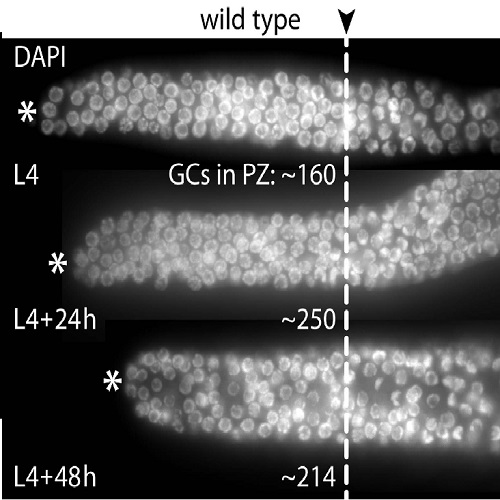GLD-4-mediated translational activation regulates the size of the proliferative germ cell pool in the adult C. elegans germ line.
To avoid organ dysfunction as a consequence of tissue diminution or tumorous growth, a tight balance between cell proliferation and differentiation is maintained in metazoans. However, cell-intrinsic gene expression mechanisms controlling adult tissue homeostasis remain poorly understood. By focusing on the adult Caenorhabditis elegans reproductive tissue, we show that translational activation of mRNAs is a fundamental mechanism to maintain tissue homeostasis. Our genetic experiments identified the Trf4/5-type cytoplasmic poly(A) polymerase (cytoPAP) GLD-4 and its enzymatic activator GLS-1 to perform a dual role in regulating the size of the proliferative zone. Consistent with a ubiquitous expression of GLD-4 cytoPAP in proliferative germ cells, its genetic activity is required to maintain a robust proliferative adult germ cell pool, presumably by regulating many mRNA targets encoding proliferation-promoting factors. Based on translational reporters and endogenous protein expression analyses, we found that gld-4 activity promotes GLP-1/Notch receptor expression, an essential factor of continued germ cell proliferation. RNA-protein interaction assays documented also a physical association of the GLD-4/GLS-1 cytoPAP complex with glp-1 mRNA, and ribosomal fractionation studies established that GLD-4 cytoPAP activity facilitates translational efficiency of glp-1 mRNA. Moreover, we found that in proliferative cells the differentiation-promoting factor, GLD-2 cytoPAP, is translationally repressed by the stem cell factor and PUF-type RNA-binding protein, FBF. This suggests that cytoPAP-mediated translational activation of proliferation-promoting factors, paired with PUF-mediated translational repression of differentiation factors, forms a translational control circuit that expands the proliferative germ cell pool. Our additional genetic experiments uncovered that the GLD-4/GLS-1 cytoPAP complex promotes also differentiation, forming a redundant translational circuit with GLD-2 cytoPAP and the translational repressor GLD-1 to restrict proliferation. Together with previous findings, our combined data reveals two interconnected translational activation/repression circuitries of broadly conserved RNA regulators that maintain the balance between adult germ cell proliferation and differentiation.

- PLoS Genet. 2014 Sep 25;10(9):e1004647
- 2014
- Cell Biology
- 25254367
- PubMed
Enabled by:
